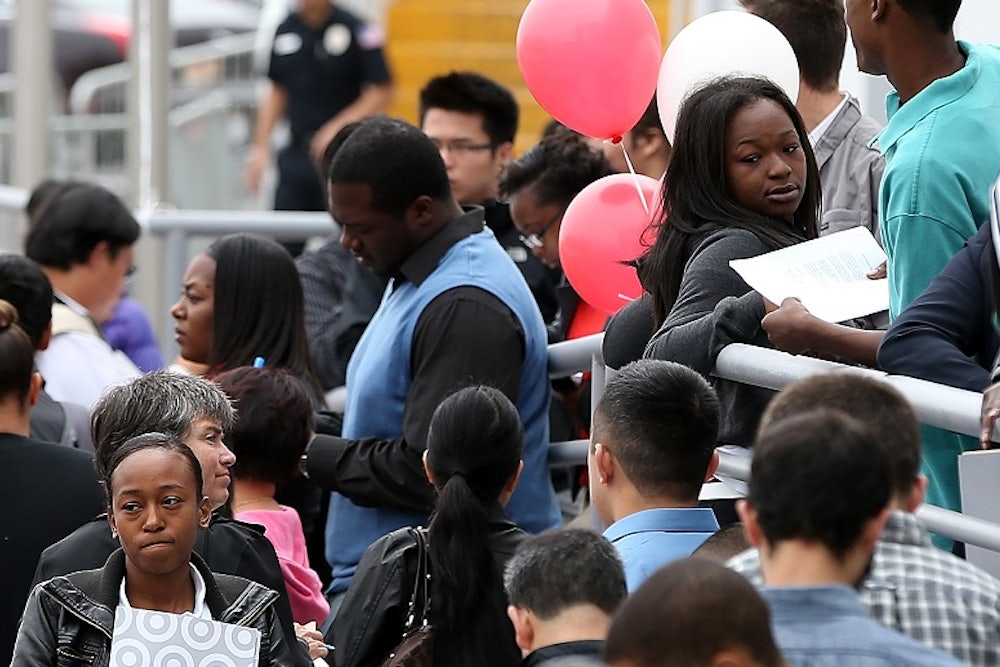For months now a debate has been raging in economic circles about the long-term unemployed. One group argues that the current unemployment rate, currently at 6.7 percent, is unrepresentative of the labor market because it doesn’t include the millions of long-term unemployed: discouraged workers who have left the labor market. The other side argues that the labor market has segmented—that those with jobs and the short-term unemployed compete for work in one labor market that is tightening, while the long-term unemployed compete in another where jobs are scarce.
A new Brookings Institute paper by Princeton economists Alan B. Krueger, Judd Cramer, and David Cho provides the strongest evidence to date that the latter group is correct. If so, the authors argue, then “a concerted effort will be needed to raise the employment prospects of the long-term unemployed.” In other words, Congress needs to act.
The long-term unemployed can become disconnected from the labor market in two ways. The first is on the labor supply-side. As time goes by, the long-term unemployed become discouraged and their job search intensity drops. Eventually, they drop out of the labor force altogether. On the labor demand side, employers discriminate against the long-term unemployed and pass over their applications out of fear that their skills have atrophied. In either case, the labor market segments.
The Brookings paper says that the longer a person is long-term unemployed, the harder it is for them to find employment. Among workers who report being unemployed for more than 27 weeks between 2008 and 2012, only 11 percent had found steady, full-time employment a year later. Thirty percent were still looking for work and 35 percent had dropped out of the labor force. The remaining 24 percent had found intermittent employment or worked part-time.
Maybe, the authors hypothesized, this only reveals how hard it has been for the long-term unemployed to find a job. As the economy recovers, employers could start hiring them at a quicker pace, indicating that the labor market has not segmented. To check that, they compared the long-term unemployment rate in states with low unemployment with that of ones with high unemployment. They found no evidence that the long-term unemployed have a better chance of finding a job in states with lower unemployment rates. In other words, an improving economy doesn’t help. Even during the late 1990s when the economy was booming, the long-term unemployed still struggled to find work:

The long-term unemployed are older, on average, than the short-term unemployed, and are slightly more likely to be minorities. Fifty-five percent of them are male and 78 percent have at least a high school diploma. As of February, there were 3.8 million long-term unemployed people in America, and many more have dropped out of the labor force altogether. They aren’t likely to return. The authors also found that 73 percent of those who left the labor force during a 16-month period of long-term unemployment indicated that they no longer wanted a job. They had become permanently unemployed.
This is the most frightening consequence of the Great Recession: working-age, able-bodied Americans who have given up. Instead of contributing to the economy, they will collect benefits from the government, such as Social Security Disability Insurance, for decades to come.
Congress can prevent this. On the supply side, unemployment benefits keep the long-term unemployed in the labor force by requiring them to continue searching for work if they want to collect unemployment. House Speaker John Boehner is blocking an extension of unemployment insurance for no legitimate reason. On the demand side, Congress could offer employers financial incentives—like a tax credit—for hiring the long-term unemployed. Even better, the government could set up a jobs program that targets the long-term unemployed. Neither side seems particularly eager for that.
For political reasons, Democrats and Republicans have both moved on to different issues. Income inequality is a more popular topic on the left, which is why President Barack Obama has focused on raising the minimum wage and expanding the Earned Income Tax Credit. Republicans, meanwhile, oppose macroeconomic policies like fiscal and monetary stimulus that help during cyclical downturns. Their jobs agenda consists of cutting spending, reducing taxes, and repealing regulations. These are all policies that might help increase long-term growth, but they cannot make up for a shortfall in aggregate demand like the U.S. has experienced since the financial crisis.
“To us, the most important policy challenges involve designing effective interventions to prevent the long-term unemployed from receding into the margins of the labor market or withdrawing from the labor force altogether, and supporting those who have left the labor force to engage in productive activities,” the authors write. “Overcoming the obstacles that prevent many of the long-term unemployed from finding gainful employment, even in good times, will likely require a concerted effort by policy makers, social organizations, communities and families, in addition to appropriate monetary policy.”
